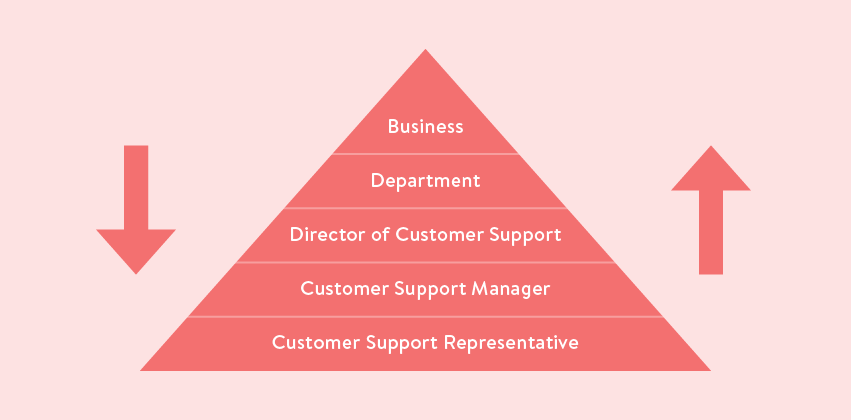Customer support goals are important for a number of reasons. Setting the right goals shows you understand the needs of your customers and what your team can do to better support them. Do not set goals randomly; they should stem from extensive research that supports why you are setting them.
Setting customer team goals
Goals should be set at company level as well as at individual level, and you should understand how all these goals work together to achieve the overall company vision. The support team’s goals compliment and work alongside the broader goals of the company.
There is often a knowledge gap between management’s conception of customer needs and what your customers actually find important. It’s imperative that the support team’s goals are communicated clearly to the rest of the business, demonstrating how these goals will fit with the company vision and meet the true needs of your customers.
Clear goals are crucial for your support team to know where they are heading and what they need to do to get there. Without defined goals, employees and managers struggle to assess progress and see whether the team is moving in the right direction.
This post explains how you can set goals for your support team, and offers some ideas for goals that you can get your team working towards today.
Are you ready to increase your team’s efficiency? Provide a better employee experience and speed up internal support with Kayako HelpDesk. Discover Kayako Self Service
Support team goals should connect the whole company
Having set expectations helps the support team, managers, and other areas of the company see how each department works towards the same overarching goal.
It might seem like setting more goals is counterintuitive and means customer support spends more time focussing on goals and less time focussing on supporting customers, but setting the right goals aids cross functional communication between different company teams.
Customer service goals and objectives
Developers and customer support might have the same goal, but the way their goal is measured will be different pertaining to their own roles and skill set. When you are open about what goals you are setting, unseen collaboration opportunities are illuminated.
- Focus employees on the purpose of your business
- Enhance your chances of success by applying your employees efforts to your company’s long-and short-term success
- Motivate employees
There are processes and concepts that people outside the customer service team do not understand, company wide goals are a great way to translate these goals into information everyone can understand.
Online bridal wear start up, Azazie is a goal orientated company. Pam, the customer service manager, says:
I’ve learned from managing my team, that goals have been able to change our statistics in customer satisfaction for the better.
Their reps are asked bi-monthly for their personal happiness levels and:
They are each held accountable for their personal satisfaction rating and the satisfaction as a whole. They find new ways to creatively help the customer and ask for ratings. As a result, our happiness levels are a solid 8/10.
What kind of goals can you set your support team?
The support team employees should not all have the same goals, as their roles can differ. There should be different goals for each role, remembering that these goals work together.
For example, the aims of the business steer the goals of the director of support who uses those goals to create goals for customer support managers and so on.

Goal setting works the other way too. Having your customer support representatives achieve their goals means the customer support managers are closer to achieving their goals and so on.
This relationship is perfectly illustrated by the story of the janitor working at NASA in the 1960s who, while sweeping the floors in the hallway, told a visitor he was helping to put a man on the moon.
When setting goals, you should check for two important things:
Firstly, check the goals are valuable but also attainable. A valuable goal is one with clear objectives that can easily be broken into smaller measurable parts for people to complete.
Having too high of expectations will do the opposite of what effective goal setting does. For example, you do not want to set a goal for 100% satisfaction. As soon as the first bad survey comes in, everyone will stop trying as hard.
Secondly, make sure you are not setting too many goals so your team becomes overwhelmed. Setting multiple goals can boost morale and keep the team focussed. You do not want to set goals for the sake of setting goals.
Whenever you set a goal, it’s crucial everyone involved understands why the goal has been set and what is measured by setting the goal.
You should experiment with your goals. If you feel you could achieve more, set the bar higher. If you feel you’re setting your expectations too high, change the goals. Goals are about empowering your team to perform better by giving them a clear understanding of why the work they do is important.
Here are a few examples of customer service team goals for you to get started with.
Director of Support
The goals of the director will be broad and will meet departmental and company-wide objectives. These goals should flow down to the rest of the department and contribute to organizational objectives.
| Goal | Reason for goal | Measured by |
| Meet SLAs 90% of the time | You want to make sure your team is efficient. Once you’ve built a strong skillful team, nurture this to ensure the team quality is maintained. | Track number of tickets that exceed a first reply time of two hours. |
| Decrease customer churn by 5% | You want to align with your department goal. | Measure MRR of existing customers each month. |
Customer Support Manager
The customer support manager’s goals should work towards ensuring the operational running of the customer support team is effective.
| Goal | Reason for goal | Measured by |
| Increase agent satisfaction by 10% | You want to make sure your team is happy. | Survey every three months to see agent satisfaction. |
| Increase NPS score by 10% per quarter | You want to identify employees who are not providing excellent customer service, and these should be coached on how to deliver better customer service for the next quarter. | Look at the current NPS, (net promoter score – the likelihood of someone recommending your service/product to their network. |
Customer Support Representative
The customer support representative’s base their goals around delivery of service and personal growth. They are often the first point of call for the customer, so it’s crucial they respond to queries in the right way. Setting measurable goals should help them achieve this.
We’ve started to do these here at Kayako and have specific goals for our customer support representatives:
| Goal | Reason for goal | Measured by |
| Increase satisfaction rating | Improved satisfaction ratings means happier customers | Reduce the number of repeat questions by 10% per quarter. |
| Contribute to company blog | Encourage evangelism and provide continuous professional development. | Whether or not the person wrote a blog post this quarter/month. |
Takeaways
Goal setting should go beyond fulfilling service level agreements for your department and should be company wide. Broad goals encourage collaboration and showcase the important work the support team does.
We set goals to be accountable for the work we do. We also do it to have an understanding of what success looks like and how we reach that.
Whether you’re a junior or senior member of staff, your goals all contribute to the greater goals of the company. Setting goals leads to greater efficiency within the team as they focus on what is actually important, rather than what they think is important. Team members are also more satisfied as they understand exactly how they can reach success.
